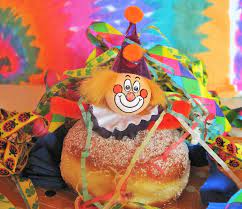The History of the Jelly Doughnut
This year Fasching (also known as Street Carnival) in Germany runs from February 16 (Altweiber or Old Ladies Day) to February 22 (Ash Wednesday). A staple of this ‘Fifth Season’, as the Germans call it, is the well-known jelly doughnut pastry called a ‘Berliner’.
The History of the Berliner
Berliner doughnuts are first recorded in a collection of recipes published in Germany in 1485. The cookbook was named Kuchenmeisterei (Mastery of the Kitchen) and was one of the first cookbooks to be run off Johannes Gutenberg’s revolutionary printing press (Source: Encyclopedia of Jewish Foods). The original doughnut name was ‘Gefüllte Krapfen’, or filled doughnuts.
The filling for the original doughnuts was usually savory, including meat, cheese or vegetables. When the Caribbean sugar plantations began to proliferate in the sixteenth century, the price of sugar fell, and in turn fruit preserves developed rapidly. The jelly doughnut was born!

Within a century of the initial appearance of the filled doughnut, every northern European country had adopted the pastry, though it was a rare treat usually associated with specific holidays (ibid source above). In the twentieth century, Germans invented a method of squirting the jam into pre-fried doughnuts. Later machines were developed to do this job. And so the jelly doughnut obtained its contemporary character, though today other non-jam fillings like latte creams or chocolate truffle have expanded the jelly doughnut’s popularity to new gourmet heights.
Why is the Jelly Doughnut Called a Berliner?
The story goes that there was once a baker from Berlin who applied for patriotic service in 1756. He was deemed unfit for Prussian military duty but was allowed to remain a field baker in one of the regiments. Because the field cooks had no access to ovens, the baker fried pieces of dough over an open fire. The soldiers began to name the popular fried dough balls ‘Berliners’ after the cook’s home town (Wikipedia).
Other names for jelly doughnuts include: Krapfen (Austria, Germany), Boule de Berlin (France), paczka or paczki (Poland), sonhos (Portugal), ponchiki or pyshki (Russian), Sufganiyah (Israel), Bismarks (American Midwest), jam busters (New England), jam doughnuts (UK).
The Connection Between the Berliner and Fasching
The origin of the jelly doughnut as a Fasching speciality goes back to the origin of Fasching itself, which is a period of celebration prior to abstinence during Lent. In the time of Lent during the Middle Ages, Christians would give up eating meat, milk products and eggs, so these products had to get used up before the six week period of abstinence began. Baking sweet treats like jelly doughnuts became a way of fulfilling this purpose while also celebrating prior to Lent’s beginning.

Christians are not the only religious group that celebrates by eating jelly doughnuts. Jewish families eat jelly doughnuts before and during Hanukkah. In Israel they are sold on almost every street corner during the holidays and are enjoyed by people in all communities and of every religious stripe (Encyclopedia of Jewish Food).
The Most Famous Berliner
Of course, the most famous Berliner wasn’t a jelly doughnut at all, but an American President.
The iconic story is from 1963, when President John F. Kennedy addressed the German people in West Berlin with one of the most famous cold war, anti-communist speeches of all time:
Today, in the world of freedom, the proudest boast is ‘Ich bin bin Berliner’!…All free men, wherever they live, are citizens of Berlin, and therefore, as a free man, I take pride in the words ‘Ich bin ein Berliner’!

Though technically he said he was a jelly doughnut, this is of course only an urban myth in non-German-speaking countries. Germans have never held President Kennedy’s claim as literal. It is a fun story though!
Sources:
Encyclopedia of Jewish Food, Wiley 2010
Wikipedia
www.mydinner.co.uk
